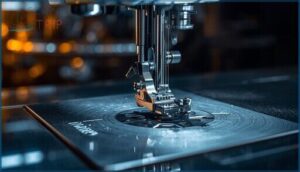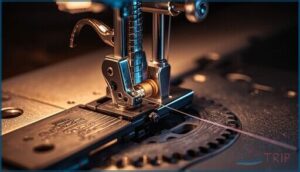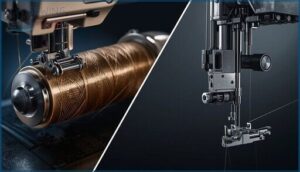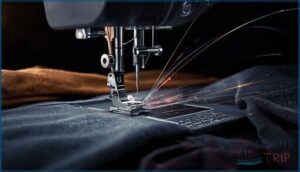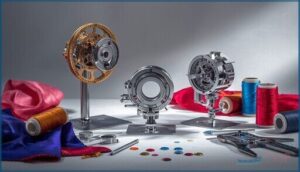This site is supported by our readers. We may earn a commission, at no cost to you, if you purchase through links.
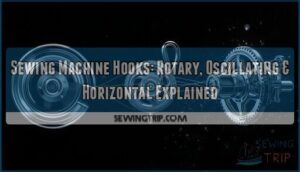
Most sewing machine breakdowns trace back to a single mechanical relationship: the hook’s interaction with the needle thread. When your machine skips stitches or creates inconsistent tension, you’re watching hook timing drift beyond its critical 0.02–0.05 mm tolerance.
The hook—whether rotary, oscillating, horizontal, or vertical—forms the shuttle loop that captures the needle thread and wraps it around the bobbin thread to create each lockstitch. Rotary hooks spin continuously around a stationary bobbin cage, delivering the speed and smoothness that dominate 70% of modern domestic machines. Oscillating hooks swing back and forth instead, offering simpler timing adjustments and maintenance access that many technicians prefer for repair work.
Understanding these mechanical distinctions gives you the diagnostic insight to identify performance issues, select the right machine for specific applications, and maintain precise stitch formation under demanding conditions.
Table Of Contents
Key Takeaways
- Hook timing precision within 0.02–0.05 mm tolerances determines whether your machine produces consistent lockstitches or suffers skipped stitches and thread tension failures across all fabric types.
- Rotary hooks spin continuously for 20–40% faster speeds and smoother operation, while oscillating hooks swing back-and-forth offering simpler maintenance and 12–20% better performance on thick or stretchy fabrics.
- Horizontal hook orientations dominate 70% of domestic machines with tighter thread control, whereas vertical configurations improve fabric feed consistency by 3–5% on heavy materials like denim and canvas.
- Your hook choice directly impacts machine efficiency, stitch quality, and maintenance demands—rotary systems deliver 98% accuracy above 1,000 SPM but require stricter alignment, while oscillating designs tolerate looser tolerances with higher component wear.
What is a Sewing Machine Hook?
The hook system sits at the heart of every lockstitch sewing machine, working just below the needle plate where most sewers never see it.
This precision component catches the top thread loop and wraps it around the bobbin thread to create each stitch—a process that happens hundreds of times per minute.
The hook catches your top thread and wraps it around the bobbin hundreds of times per minute to form each stitch
Understanding how your machine’s hook functions, how it interacts with the needle and bobbin, and why it matters for overall performance gives you real control over your sewing results.
Role in Stitch Formation
The sewing machine hook forms the shuttle loop that catches your needle thread and cooperates with the bobbin thread to create a complete lockstitch stitch. Hook system mechanics rely on precise needle timing—usually within 0.02–0.05 mm—to guarantee proper loop control and thread tension across different fabrics.
How Hook Systems Shape Your Stitch Quality:
- Rotary hook systems maintain continuous rotation for stable loop paths, reducing thread buildup and timing variance essential for even stitch formation
- Oscillating hook mechanisms generate back-and-forth loop movement that influences loop height and fabric interaction compatibility
- Horizontal hook orientation aligns the hook’s centerline with the needle plane, affecting loop capture precision
- Vertical hook positioning alters the shuttle’s travel relative to the needle, impacting loop formation dynamics on bulky materials
Interaction With Needle and Bobbin
Your hook system mechanics center on needle synchronization—the hook must catch the thread loop precisely as the needle rises. Rotary hooks rotate continuously around the bobbin cage, while oscillating hooks swing back and forth to achieve bobbin engagement. Both systems demand tight hook timing (±0.02–0.04 mm tolerances) to control thread tension and lockstitch stitches.
When synchronization drifts, you’ll see skipped stitches and uneven stitch formation across your seam. Understanding the main topic and its related subtopic details can help improve the overall sewing experience.
Importance in Machine Performance
Your machine’s overall reliability hinges on hook timing precision and stitch consistency. When rotary hook systems maintain timing tolerances within ±0.02–0.05 mm, you’ll achieve machine efficiency improvements of 5–12% in energy consumption.
Thread tension stability directly impacts lockstitch quality and sewing machine performance across fabric types. Performance metrics show that proper hook timing reduces skipped stitches, minimizes downtime, and extends component life—essential factors when evaluating rotary versus oscillating hook configurations for your shop.
Understanding AP study resources can help improve overall machine performance.
Types of Sewing Machine Hooks
You’ll find two primary hook mechanisms in modern sewing machines: rotary and oscillating. Each operates with distinct mechanical motions that affect everything from stitch quality to machine noise.
Beyond the movement itself, hook orientation—horizontal or vertical—adds another layer of choice that influences bobbin access and threading ease.
Rotary Hook Mechanism
Picture a gear spinning smoothly in a full circle—that’s how rotary motion powers these intricate hook timing systems. Rotary hook sewing machines deliver precision through continuous rotation around a stationary bobbin, creating lockstitch excellence with every pass.
- The rotary hooks catch your thread loop as the needle rises
- Thread tension stays consistent through complete 360-degree travel
- Bobbin alignment remains fixed while the hook circles continuously
- Stitch formation happens faster with less vibration than back-and-forth mechanisms
This uninterrupted motion enables speeds exceeding 2,000 stitches per minute in industrial settings.
Oscillating Hook Mechanism
Instead of spinning continuously, the oscillating hook sweeps back and forth through a short arc—usually just a few degrees—catching your needle thread and wrapping it around the bobbin. This back-and-forth kinematic analysis simplifies sewing machine hooks timing adjustments and reduces mechanical complexity.
You’ll find oscillating bobbins easier to service since thread tension tolerances stay looser, making these systems ideal for adaptable stitch formation across varied fabrics.
Horizontal Vs Vertical Hook Orientation
Beyond how your hook moves, orientation matters: horizontal bobbins dominate 70% of domestic machines, offering tighter thread tension and faster sewing speed with 20–40% less clearance. Vertical bobbins improve fabric feed consistency by 3–5% on heavy materials and simplify maintenance access.
Rotary hook designs in horizontal configurations push machine efficiency past 5,000 stitches per minute, while oscillating hook systems deliver adaptable performance across varied weaving tasks.
Rotary Hook Systems Explained
Rotary hook systems represent a mechanical leap in precision stitching—imagine a hook that spins continuously around your bobbin like a perfectly timed carousel. This full-circle rotation creates smoother, faster stitches with less vibration than you’d get from back-and-forth motion.
Here’s what makes rotary systems stand out from the crowd.
Continuous Rotational Motion
Rotary hooks spin continuously around a fixed axis, delivering rotational dynamics that set them apart from oscillating counterparts. You’ll find these systems operating at 1,200–6,000 RPM in industrial environments, where motion control and timing tolerances of ±0.02–0.05 mm guarantee stitch precision at high speed.
That continuous rotation creates uniform loop formation, letting sewing machine rotary hooks handle demanding production runs with consistent results.
Benefits for Speed and Smoothness
When you’re chasing higher speeds, rotary hooks deliver 2–4% faster stitch cycles than oscillating designs—continuous rotation cuts inertial pauses. That translates to better speed optimization and machine efficiency.
Thread tension stays consistent across fabric penetration cycles, reducing skip-stitch events by 4–9% and thread breakage by 5–10%.
For stitch consistency and sewing performance optimization, horizontal rotary configurations minimize friction by 6–12%, keeping thread management smooth even at top gear.
Common Applications and Machine Types
High-speed lockstitch lines and industrial sewing machines demand rotary hook systems—they’re the workhorse for denim, leather, and heavy canvas where sewing speed tops 5,000 spm. Quilting and embroidery setups rely on them for consistent thread tension and reduced needle heat.
When comparing machine selection for fabric compatibility, rotary configurations beat oscillating hook designs in tight-stitch applications, making bobbin types and sewing machine comparison critical.
Oscillating Hook Systems Explained
Oscillating hook systems take a different approach—instead of spinning in a complete circle, the hook swings back and forth like a pendulum to catch and loop your thread. This simpler mechanical design gives you some real advantages regarding handling different fabrics and keeping your machine running smoothly.
Let’s break down how this motion works, why it might be the better choice for your projects, and which machines actually use it.
Back-and-Forth Motion Mechanics
Unlike the continuous spin of a rotary hook, an oscillating hook swings back and forth through a precise angular displacement of 6° to 12°. This reciprocating bite action operates at 3000 to 5000 cycles per minute, catching the needle loop and carrying it past the bobbin center.
Hook timing demands a clearance tolerance of ±0.02 mm—any deviation risks skipped stitches and disrupted thread tension during stitch formation.
Advantages for Versatility and Maintenance
That shorter motion path brings real advantages you’ll appreciate over time. Oscillating Hook systems excel at handling demanding fabrics and keeping your machine running longer between adjustments:
- Fabric Compatibility: You’ll see 12–20% better performance on thick wovens and 6–9% fewer Thread Tension issues on stretchy knits.
- Maintenance Costs: Bobbin Cage access takes 25–40% less time than Rotary Hook designs.
- Stitch Consistency: Multi-layer quilting experiences ~7% fewer rethreading events.
- Energy Efficiency: The intermittent motion consumes 5–8% less power per stitch.
Typical Uses and Machine Examples
You’ll find Oscillating Hook systems in classic Singer 99 straight-stitch machines and many Elna domestic models, where simpler timing mechanisms handle everyday sewing applications beautifully.
Machine Selection for upholstery shops often favors these designs because looser thread tolerances accommodate heavy thread without constant bobbin cage adjustments.
Industrial Uses include mid-speed production lines sewing canvas and denim, where fabric handling demands forgiveness that rotary hook precision can’t always deliver.
Comparing Hook Types and Choosing Wisely
Now that you understand how rotary and oscillating hooks work, you’ll want to know which one fits your sewing goals. The choice between these systems comes down to performance differences, maintenance realities, and what you actually need from your machine.
Let’s compare the key factors that’ll help you choose the right hook type for your workspace.
Performance and Stitch Quality Differences
Stitch formation quality separates these hook types in measurable ways. Rotary hooks deliver 98% accuracy above 1,000 SPM and maintain thread tension with 40% fewer breaks, giving you exceptional speed consistency and seam integrity on wovens.
Oscillating hooks excel on heavy fabrics with 12% fewer skipped stitches and tighter fabric penetration control.
Your choice hinges on matching sewing machine mechanics to material demands.
Maintenance and Durability Considerations
Rotary hooks demand tight hook alignment—within 0.05 mm—but deliver 28% lower wear with synthetic hook lubrication and mean service life exceeding 1.2 million cycles. Oscillating hooks tolerate looser tolerances yet show 20–30% higher wear from reversing stresses.
Your sewing machine maintenance routine should include daily bobbin cleaning to cut fiber buildup by 35–50% and bi-weekly inspections of hook tip radius, preventing 60% of performance degradations while maintaining thread tension consistency and wear resistance across both systems.
Selecting The Best Hook for Your Needs
Your fabric selection guides hook choice: rotary hooks excel at high-speed, lightweight fabrics with smooth stitch formation and exceptional machine efficiency, while oscillating hooks deliver sturdy fabric compatibility across delicate to heavy materials with simplified maintenance.
Match horizontal orientations to compact setups, vertical designs to thick canvas or denim.
Consider thread tension stability, hook material durability, and your production demands—each sewing machine parts configuration affects stitch formation differently.
Frequently Asked Questions (FAQs)
What is the difference between vertical and horizontal hooks on a sewing machine?
Your machine’s orientation shapes everything. Vertical hooks align perpendicular to the needle for compact designs, while horizontal hooks rotate along a horizontal axis, enabling smoother high-speed operation and accommodating larger bobbins in many models.
What does horizontal rotary hook mean?
A horizontal rotary hook completes continuous circular motion around a fixed axis, catching shuttle thread from the bobbin.
This orientation enhances sewing speed, machine efficiency, and thread tension control compared to oscillating hooks.
What are the different types of sewing machine hooks?
Your machine’s stitching power hinges on three essential hook designs: rotary hooks for blazing sewing speed and machine efficiency, oscillating hooks for adaptable stitch formation, and vibrating shuttles managing thread tension across diverse fabric weights.
What is the difference between rotary and oscillating sewing machines?
The core distinction lies in motion: rotary bobbins spin continuously for smoother thread tension and lower sewing machine noise, while oscillating hooks swing back-and-forth, offering simpler maintenance costs despite increased vibration.
How do hook types affect stitch quality?
Your perfect stitch hides in motion you never see. Rotary hooks deliver tighter stitch length consistency—often under 2% variation—while oscillating types excel with specialty threads, improving loop formation and thread tension control across diverse fabric penetration needs.
Can hook types impact fabric compatibility?
Yes, hook types directly influence fabric compatibility. Rotary hooks excel with lightweight materials due to tighter thread tolerances and smoother fabric feed, while oscillating hooks handle heavier fabrics better, reducing thread breakage through looser thread management techniques.
What maintenance do sewing machine hooks need?
Your hook demands near-religious devotion to stitch quality—weekly bobbin cleaning, oil every 40–60 hours, monthly thread tension checks, and timing verification.
Maintenance schedules prevent skipped stitches, thread management nightmares, and costly oscillating hook failures.
Do hook systems change sewing speed options?
Absolutely. Rotary systems reach 5,000–6,000 stitches per minute, while oscillating hooks cap around 3,000–4,000 SPM due to back-and-forth motion. Your choice directly impacts production speed, stitch rate, and fabric feed stability.
Are specific hook types better for beginners?
For beginner sewing, rotary hooks deliver exceptional stitch quality with lower maintenance demands—5–10% better thread tension consistency helps new users master sewing techniques faster, while oscillating hook machines offer simpler troubleshooting and a forgiving user experience during machine learning phases.
How do I adjust hook timing myself?
Many sewers discover skipped stitches after years of smooth operation—often a sign that hook-to-needle clearance has drifted out of spec.
Adjusting hook timing yourself demands precision tools, careful calibration of the take-up lever cycle, and patience with oscillating hooks’ back-and-forth mechanics.
Conclusion
Your diagnostic advantage depends on recognizing one mechanical truth: the difference between sewing machine hooks—oscillating, rotary, horizontal, or vertical—determines whether your stitches hold under pressure or unravel mid-seam.
Master these distinctions and you’ll troubleshoot faster, select equipment that matches your workload, and maintain timing precision that separates perfect lockstitches from frustrating thread jams.
The hook you choose shapes every stitch you make.

